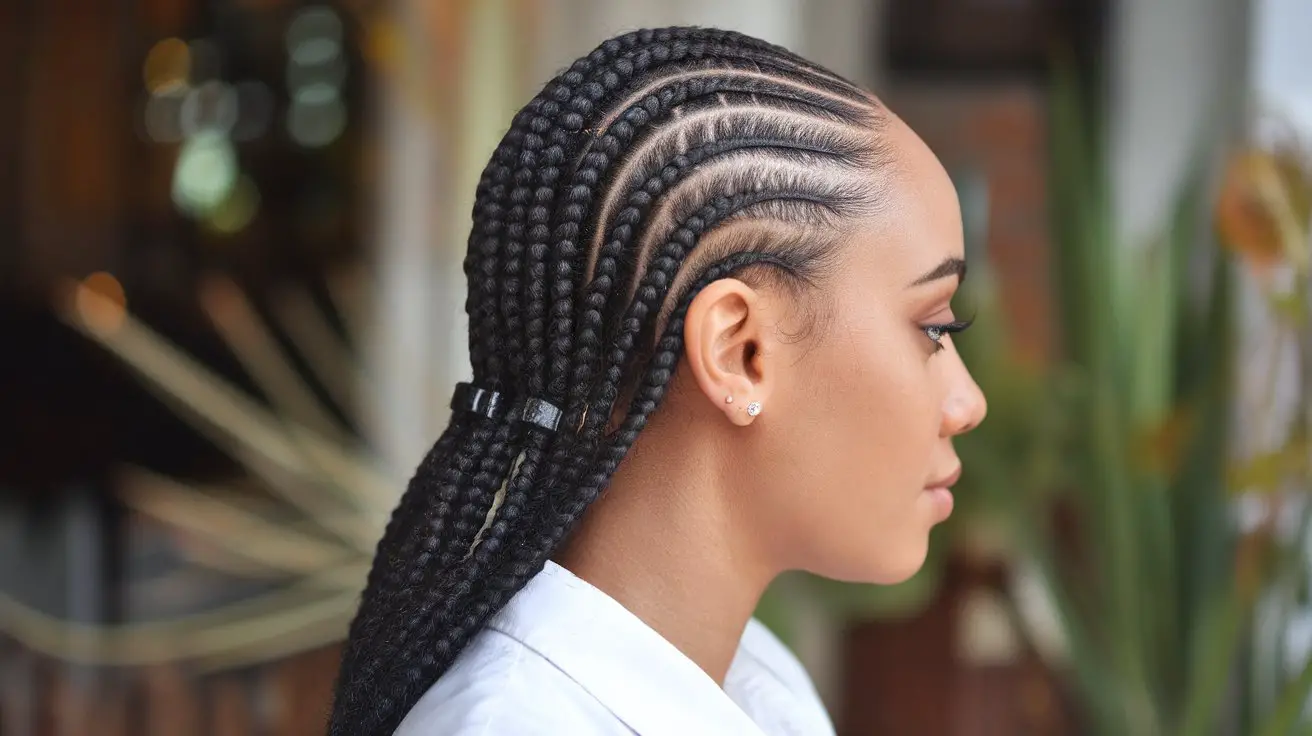Fulani braids are a stunning hairstyle that can completely change your look. These intricate braids, characterized by their distinctive center braid and beautiful patterns, have their roots in the Fulani people of West Africa. Women have worn this traditional style for centuries, passing down the techniques from generation to generation.
In recent years, Fulani braids have gained widespread popularity beyond their cultural origins. Women around the world have fallen in love with this versatile and eye-catching hairstyle. The braids offer a perfect blend of tradition and modern style, making them suitable for various occasions, from casual outings to formal events.
The following sections will explore what makes Fulani braids special, how to prepare your hair for this style, and some of the most beautiful variations you can try. We’ll also discuss how long these braids typically last and share tips on how to care for them properly. Keep reading to discover how Fulani braids can transform your appearance and boost your confidence.
What makes Fulani braids unique?
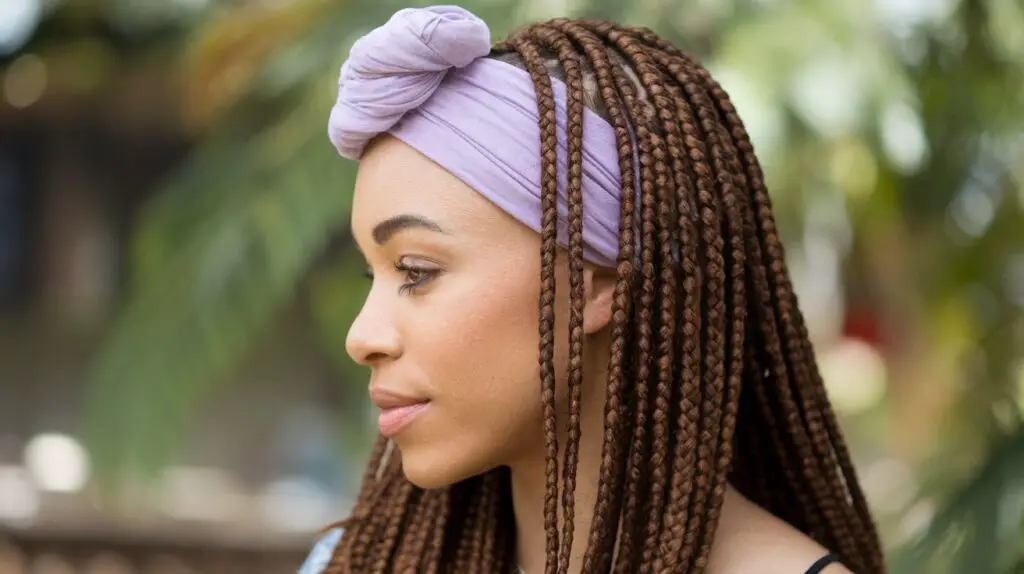
Fulani braids stand out from other hairstyles due to their distinctive features and rich cultural heritage. These braids offer a beautiful blend of tradition and modern style, making them a popular choice for women seeking a unique look.
Distinctive center braid
The most recognizable feature of Fulani braids is the center braid that runs from the forehead to the nape of the neck. This single braid serves as the focal point of the hairstyle, drawing attention to the face and creating a symmetrical look. The center braid is often thicker than the surrounding braids, adding depth and dimension to the overall style.
Why is the center braid so important? It’s not just about aesthetics. The center braid has cultural significance, representing the path of life in Fulani tradition. It’s a symbol of unity and continuity, connecting the past to the present.
Intricate patterns and designs
Surrounding the center braid, you’ll find an array of intricate patterns and designs. These can range from simple straight-back braids to more complex geometric shapes. The creativity in these patterns is what truly sets Fulani braids apart.
Some popular design elements include:
- Zigzag partings
- Curved lines
- Diamond-shaped sections
- Cornrow variations
These patterns aren’t just for show. They reflect the artistic expression of the Fulani people and showcase the skill of the braider. Each design tells a story, making your hairstyle a work of art.
Use of beads and cowrie shells
One of the most charming aspects of Fulani braids is the incorporation of decorative elements. Beads and cowrie shells are often woven into the braids, adding a touch of sparkle and cultural significance to the style.
Beads come in various colors and materials, allowing for personalization. You can choose beads that match your outfit or opt for traditional wooden or metal beads. Cowrie shells, on the other hand, have been used in African hairstyles for centuries. They symbolize wealth, fertility, and spiritual protection in many African cultures.
Versatility in styling
Despite their traditional roots, Fulani braids offer incredible versatility. You can adapt this style to suit various occasions and personal preferences. Want a more casual look? Leave the braids loose and flowing. Need something more formal? Gather the braids into an updo or bun.
The length of Fulani braids can also be customized. Some women prefer shorter braids that fall just below the shoulders, while others opt for long, dramatic braids that reach the waist or beyond. You can even experiment with different hair colors to create a truly unique look.
Cultural significance
Understanding the cultural significance of Fulani braids adds depth to your appreciation of this hairstyle. Originating from the Fulani people of West Africa, these braids have been worn for generations. They’re not just a fashion statement; they’re a connection to a rich cultural heritage.
In Fulani culture, hairstyles often indicate a person’s age, marital status, and social position. The intricate designs and patterns in the braids can convey messages and tell stories. By wearing Fulani braids, you’re participating in a tradition that spans centuries and continents.
It’s important to approach this hairstyle with respect for its origins. While anyone can wear Fulani braids, acknowledging their cultural roots and significance shows appreciation rather than appropriation.
Fulani braids offer a beautiful way to express yourself while honoring a rich cultural tradition. Their distinctive features, from the center braid to the intricate patterns and decorative elements, make them a truly special hairstyle. Whether you’re drawn to their aesthetic appeal or their cultural significance, Fulani braids provide a unique opportunity to transform your look and connect with a fascinating heritage.
How to prepare your hair for Fulani braids
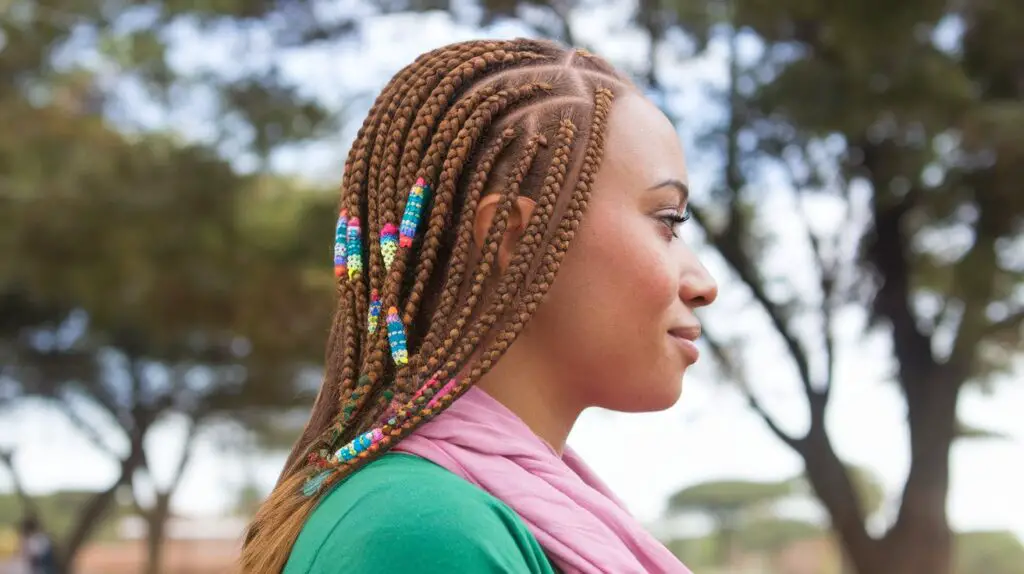
Preparing your hair for Fulani braids is a crucial step that can make or break your final look. This traditional hairstyle requires careful preparation to achieve the best results and protect your natural hair. Let’s explore the essential steps to get your hair ready for this beautiful style.
Deep conditioning treatment
Before you start the braiding process, giving your hair a deep conditioning treatment is vital. This step helps to moisturize and strengthen your hair, making it more resilient to the tension of braiding. How often should you deep condition? Ideally, you should do this at least a week before getting your Fulani braids.
To get the most out of your deep conditioning treatment:
- Use a product rich in natural oils and proteins
- Apply the conditioner from root to tip
- Leave it on for 30 minutes to an hour
- Rinse thoroughly with cool water
Remember, well-moisturized hair is less likely to break or become damaged during the braiding process.
Detangling and sectioning
Once your hair is clean and conditioned, it’s time to detangle and section it. This step is crucial for creating smooth, even braids. Start by using a wide-tooth comb or detangling brush to gently remove any knots or tangles. Work in small sections, starting from the ends and moving up to the roots.
After detangling, divide your hair into manageable sections. The number of sections will depend on your hair thickness and the complexity of your chosen Fulani braid design. Use hair ties or clips to keep each section separate and neat.
Choosing the right hair extensions
Selecting the right hair extensions is key to achieving the look you want. Consider factors like length, texture, and color when choosing your extensions. Synthetic hair is often used for Fulani braids due to its affordability and variety of colors, but human hair extensions can also be used for a more natural look.
What’s the best length for Fulani braids? This depends on your personal preference, but many women opt for extensions that reach mid-back to waist length. As for texture, look for extensions that match or complement your natural hair texture for the most seamless blend.
Scalp care and preparation
Your scalp needs special attention before braiding. A healthy scalp provides a good foundation for your Fulani braids and can help prevent irritation or discomfort during the styling process.
Start by thoroughly cleansing your scalp to remove any buildup of dirt, oil, or product residue. You might want to use a clarifying shampoo for this step. After cleansing, apply a light moisturizer or oil to your scalp. This helps to soothe and nourish the skin, reducing the risk of dryness or itching once your braids are installed.
Gathering necessary tools and accessories
Having the right tools on hand can make the braiding process smoother and more efficient. Here’s a list of items you’ll need:
- Rat-tail comb for precise parting
- Hair clips or ties for sectioning
- Edge control gel or pomade
- Moisturizing leave-in conditioner
- Beads, cowrie shells, or other decorative elements
- Braid spray for maintenance
Don’t forget to have a mirror handy so you can check the progress of your braids from different angles.
By following these preparation steps, you’re setting yourself up for a successful Fulani braiding experience. Taking the time to properly condition, detangle, and section your hair will make the braiding process easier and help protect your natural hair. Choosing the right extensions and accessories allows you to customize your look, while proper scalp care ensures comfort throughout the time you wear your braids.
Remember, the key to beautiful Fulani braids lies in the preparation. With your hair and scalp properly prepped, and all your tools at the ready, you’re well on your way to stunning, head-turning Fulani braids that will make you feel confident and beautiful.
What are the most stunning Fulani braid styles?
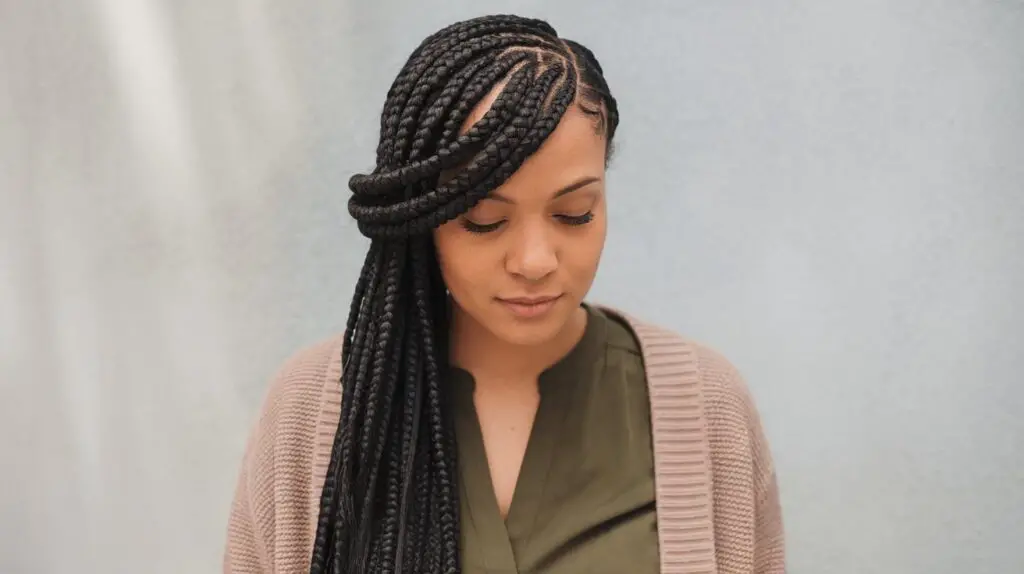
Fulani braids offer a wide array of stunning styles that can transform your look. These versatile hairstyles allow for creative expression while maintaining their traditional roots. Let’s explore some of the most eye-catching variations you can try.
Classic Fulani braids with beads
The timeless appeal of classic Fulani braids with beads never goes out of style. This look features thin, precise braids adorned with small beads, typically placed near the face or scattered throughout the hair. The beads can be wooden, glass, or plastic, and come in various colors to match your outfit or mood.
Why choose this style? It’s a perfect blend of tradition and modern fashion. The beads add a playful touch to the sleek braids, creating a look that’s both elegant and fun. You can opt for a single color scheme or mix and match for a more vibrant appearance.
Fulani braids with colorful threads
Want to add a pop of color to your hairstyle? Fulani braids with colorful threads might be just what you’re looking for. This style incorporates vibrant threads woven into the braids, creating striking patterns and designs.
The beauty of this variation lies in its customization options. You can choose threads that match your favorite colors, represent your cultural heritage, or simply complement your skin tone. Some popular thread color combinations include:
- Rainbow hues for a bold, festive look
- Earth tones for a more subtle, natural appearance
- Metallic threads for a touch of glamour
Half-up, half-down Fulani braids
For those who want the best of both worlds, half-up, half-down Fulani braids offer a perfect solution. This style combines the structure of braids with the freedom of loose hair, creating a look that’s both sophisticated and relaxed.
How does it work? The top section of your hair is braided in the traditional Fulani style, often featuring the signature center braid. The lower half is left loose, allowing your natural texture to shine through. This versatile style can be dressed up for formal occasions or worn casually for everyday activities.
Fulani braids with geometric patterns
If you’re feeling adventurous, why not try Fulani braids with geometric patterns? This style takes the traditional braiding technique to the next level by incorporating intricate designs into the braided sections.
The possibilities are endless when it comes to geometric patterns. You might choose diamond shapes, zigzags, or even more complex designs like stars or spirals. These patterns are created through careful parting and braiding techniques, resulting in a hairstyle that’s truly a work of art.
Keep in mind that this style requires significant skill and time to execute properly. It’s best to seek out an experienced braider who specializes in complex Fulani braid patterns.
Fulani braids with metallic cuffs
For a touch of glamour, consider Fulani braids adorned with metallic cuffs. This style adds a modern, edgy twist to the traditional look. Small metal cuffs or rings are slipped onto individual braids, creating a shimmering effect that catches the light as you move.
The placement of these metallic accents can vary. Some women prefer to concentrate them around the face for maximum impact, while others distribute them evenly throughout the braids. You can choose from gold, silver, or even rose gold cuffs to match your personal style and skin tone.
One advantage of this style is its versatility. The cuffs can be easily added or removed, allowing you to switch up your look without redoing your entire hairstyle. This makes it a great option for those who like to change their appearance frequently.
When choosing metallic cuffs, consider the size and weight. Lighter cuffs are generally more comfortable for everyday wear, while larger, more ornate pieces can create a dramatic look for special occasions.
Fulani braids offer a wealth of styling options, from classic beaded looks to modern geometric patterns. Whether you prefer a subtle, traditional appearance or a bold, colorful style, there’s a Fulani braid variation that can suit your taste. By experimenting with different elements like beads, threads, and metallic accents, you can create a hairstyle that’s uniquely yours while honoring the rich cultural heritage of this braiding technique.
How long do Fulani braids typically last?
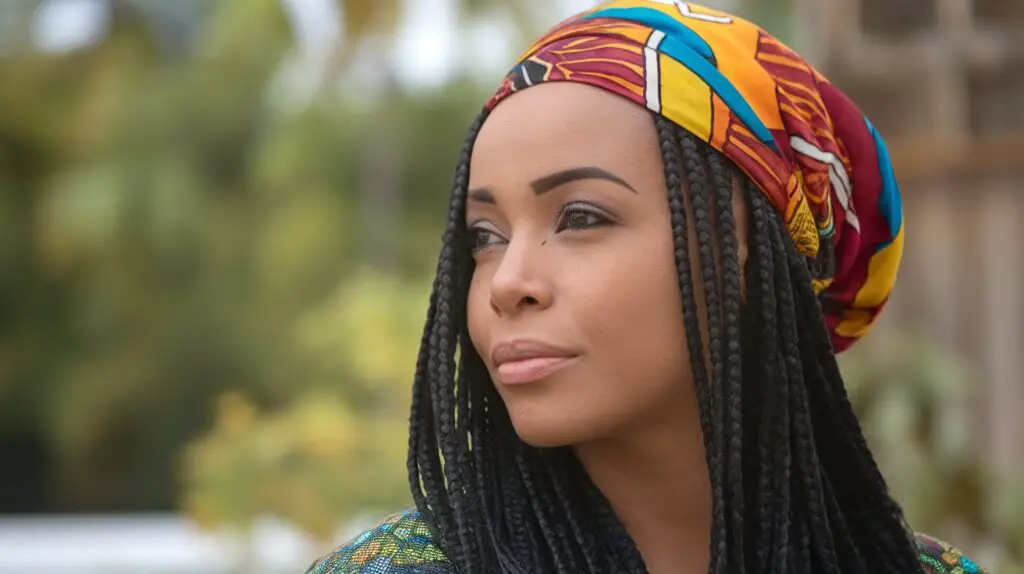
The lifespan of Fulani braids is a common question among women considering this beautiful hairstyle. Let’s explore how long you can expect your braids to last and what factors influence their longevity.
Average duration of the style
Typically, Fulani braids can last anywhere from 4 to 6 weeks. This timeframe allows you to enjoy your hairstyle for a considerable period while minimizing potential damage to your natural hair. However, it’s important to note that this is just an average, and your individual experience may vary.
Some women find their braids looking fresh for up to 8 weeks, while others prefer to remove them after 3 weeks. The key is to listen to your hair and scalp, and make decisions based on your personal comfort and hair health.
Factors affecting longevity
Several elements can impact how long your Fulani braids remain in good condition. Your hair type plays a significant role – those with thicker, coarser hair might find their braids lasting longer than those with fine or slippery hair textures.
Other factors that can affect the lifespan of your braids include:
- Your lifestyle and activity level
- The quality of hair extensions used
- The skill of your braider
- Your hair care routine
For instance, if you’re very active or swim frequently, you might notice your braids loosening more quickly. Similarly, using high-quality hair extensions and having your braids installed by an experienced stylist can contribute to a longer-lasting style.
Signs it’s time to remove the braids
How do you know when it’s time to say goodbye to your Fulani braids? Pay attention to these indicators:
Excessive frizz: While some frizz is normal, if your braids become excessively fuzzy, it might be time for removal.
Visible new growth: If you can see more than an inch of new growth at your roots, consider taking out your braids to prevent tangling and matting.
Scalp irritation: Any persistent itching, redness, or discomfort is a sign that your braids should come out.
Loosening braids: If many of your braids are coming loose or unraveling, it’s better to remove them than to risk damaging your hair.
Proper maintenance for longer wear
To maximize the lifespan of your Fulani braids, proper care is essential. Start by keeping your scalp clean and moisturized. Use a diluted shampoo or a dry shampoo to cleanse your scalp without causing frizz. Apply a light oil to your scalp and the length of your braids to keep them hydrated.
At night, protect your braids by wrapping them in a silk or satin scarf. This reduces friction and helps maintain the neatness of your style. During the day, you can use a light hold spray to tame any flyaways and keep your braids looking fresh.
Regular touch-ups can also extend the life of your braids. Gently re-braid any loose sections, and smooth down your edges with a small amount of edge control product.
Balancing style duration with hair health
While it’s tempting to keep your Fulani braids in for as long as possible, it’s crucial to prioritize the health of your natural hair. Wearing braids for too long can lead to breakage, thinning, and even traction alopecia – a form of hair loss caused by prolonged tension on the hair follicles.
To strike a balance, consider giving your hair a break between braiding sessions. This allows your scalp to breathe and your hair to recover. During these breaks, focus on deep conditioning treatments and gentle styling to nurture your natural hair.
If you frequently wear Fulani braids, you might want to alternate between styles that put tension on different areas of your scalp. This can help prevent stress on the same hair follicles over time.
Remember, the goal is to enjoy your beautiful Fulani braids while maintaining the health and strength of your natural hair. By paying attention to your hair’s needs and following proper care techniques, you can rock this stunning style without compromising your hair’s well-being.
Ultimately, the longevity of your Fulani braids depends on a combination of factors, including your hair type, maintenance routine, and personal preferences. By understanding these elements and listening to your hair, you can enjoy this beautiful style for its optimal duration.
What’s the best way to care for Fulani braids?
Caring for Fulani braids properly can extend their lifespan and keep your hair healthy. Let’s explore some effective techniques to maintain this beautiful hairstyle.
Gentle cleansing techniques
Keeping your scalp clean is crucial, but how do you wash your hair without ruining your braids? The key is to focus on your scalp rather than the braids themselves. Use a diluted shampoo or a specially formulated braid cleanser. Apply it to your scalp using your fingertips, gently massaging to remove dirt and buildup.
For those who prefer a no-water method, dry shampoo can be a lifesaver. Sprinkle it onto your scalp, let it sit for a few minutes, then gently brush it out. This absorbs excess oil and refreshes your scalp without wetting your braids.
Remember, less is more when it comes to washing. Aim to cleanse your scalp once a week or every two weeks, depending on your hair type and lifestyle.
Moisturizing the scalp and braids
Hydration is essential for maintaining healthy hair and scalp. A well-moisturized scalp reduces itching and flaking, while hydrated braids stay neat and frizz-free longer. But how do you moisturize without causing buildup?
Light oils are your best friends here. Jojoba, argan, or grapeseed oil are excellent choices. They’re lightweight enough to penetrate the scalp without leaving a greasy residue. Apply a small amount to your fingertips and gently massage it into your scalp.
For the braids themselves, use a leave-in conditioner spray. Spritz it lightly over your braids, focusing on the ends where dryness is most likely to occur. Be careful not to oversaturate, as this can lead to frizz and loosening of the braids.
Protecting the style while sleeping
Your nighttime routine can make or break your Fulani braids. Tossing and turning on a cotton pillowcase can cause friction, leading to frizz and loosening of your braids. So, what’s the solution?
Invest in a satin or silk pillowcase. These smooth fabrics reduce friction, helping your braids stay neat and tidy. Even better, use a satin or silk scarf to wrap your hair before bed. This not only protects your braids but also helps maintain your edges.
Here’s a simple nighttime routine for your Fulani braids:
- Gently gather your braids into a loose, high ponytail
- Wrap a satin scarf around your edges and the base of the ponytail
- Secure the rest of your braids with a large, soft scrunchie
- Sleep on a satin pillowcase for extra protection
Refreshing the edges and baby hairs
Your edges and baby hairs often need extra attention to keep your style looking fresh. These delicate hairs can become frizzy or unruly faster than the rest of your braids. To keep them in check, use a small, soft-bristled brush and a light edge control product.
Apply a small amount of edge control to your brush and gently smooth down your edges. Be careful not to apply too much product or brush too harshly, as this can lead to breakage. For baby hairs, use a clean toothbrush to style them into subtle swirls or waves.
Avoiding common care mistakes
Even with the best intentions, it’s easy to make mistakes when caring for Fulani braids. One common error is over-moisturizing. While hydration is important, too much moisture can lead to product buildup and even mold growth in your braids. Stick to light, infrequent applications of moisturizing products.
Another mistake is neglecting your scalp. Your scalp needs to breathe, so avoid piling on heavy products that can clog your pores. If you notice any itching or flaking, address it promptly with a gentle scalp treatment.
Lastly, resist the urge to constantly touch or play with your braids. This can lead to frizz and loosening. If you need to style your braids, do so gently and infrequently.
By following these care tips, you can keep your Fulani braids looking fresh and beautiful for weeks. Remember, the goal is to maintain both the style and the health of your hair underneath. With proper care, you can enjoy your stunning braids while nurturing your natural hair.
Elevate Your Style with Fulani Braids: A Timeless Beauty Choice
Fulani braids offer a stunning way to express your personal style while honoring a rich cultural tradition. From classic beaded looks to modern geometric patterns, these versatile braids can be customized to suit your unique taste. By understanding proper care techniques, you can maintain the beauty of your braids for weeks, keeping your hair healthy and your look fresh.
Remember, the key to gorgeous Fulani braids lies in both the initial styling and ongoing maintenance. Take the time to prepare your hair properly, choose a style that resonates with you, and follow a gentle care routine. With the right approach, you’ll not only rock a beautiful hairstyle but also nurture your natural hair in the process. So go ahead, transform your look with Fulani braids and enjoy the confidence that comes with wearing this eye-catching and meaningful hairstyle.
Frequently Asked Questions
Q: How long do Fulani braids typically last?
A: Fulani braids usually last between 4 to 6 weeks, depending on factors like hair type, maintenance, and lifestyle.
Q: What makes Fulani braids unique?
A: Fulani braids are characterized by a distinctive center braid, intricate patterns, and often include decorative elements like beads or cowrie shells.
Q: How should I prepare my hair for Fulani braids?
A: Prepare your hair with a deep conditioning treatment, detangle thoroughly, and section your hair before braiding.
Q: Can I wash my hair with Fulani braids?
A: Yes, you can clean your scalp using a diluted shampoo or dry shampoo, focusing on the scalp rather than the braids themselves.
Q: How often should I moisturize my Fulani braids?
A: Moisturize your scalp and braids 1-2 times a week using lightweight oils and a leave-in conditioner spray.
Q: What’s the best way to protect Fulani braids while sleeping?
A: Protect your Fulani braids by sleeping on a satin pillowcase or wrapping your hair in a satin scarf before bed.
Q: How can I keep my edges neat with Fulani braids?
A: Maintain neat edges by using a soft-bristled brush and a light edge control product, applying gently to avoid breakage.
Q: Are there any common mistakes to avoid when caring for Fulani braids?
A: Avoid over-moisturizing, neglecting your scalp, and constantly touching or playing with your braids to maintain their longevity and appearance.

